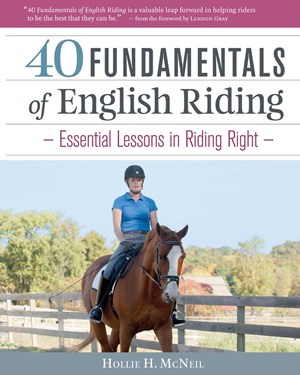Book & DVD Review

40 Fundamentals of English Riding: Essential Lessons in Riding Right
By Hollie H. McNeil
Available at HorseBooksEtc.com or by calling (800) 952-5813.
Reviewed by Lindsay Brown
For all riding enthusiasts near the beginning of their riding career and looking to start things off right, Hollie McNeil’s new book is a must-have for your horse library. As Lendon Gray points out in her introduction, all riders who are looking to enhance their riding education should supplement their time in the saddle with reading.
This is actually a book–DVD combo that provides a thorough verbal and visual learning experience. The book is broken down into sections that focus on a different one of McNeil’s “40 Fundamentals,” which include topics such as rider position, aids, gaits, the training scale, flexion, bending, half halts, schooling figures and lateral work. While many of the topics are geared toward the dressage enthusiast, they are the same fundamentals that build a strong rider in any discipline.
Above all else, clarity is the greatest achievement of this resource. The writing is clear, the analogies are strong and concise, the photos in the book are clean and make it easy to observe what is being demonstrated. The video puts it all together, demonstrating what the concepts look like in motion. Both the photos and video footage are taken from various angles that clearly demonstrate many riding essentials not easily visible from the traditional side view. For example, McNeil includes views from above to help demonstrate bend, flexion, rein aids, arena figures and various other fundamentals.
Each section of the book provides an overview of the covered topic along with a useful analogy that really helps the reader understand exactly what the author is trying to communicate. For example, McNeil says “Think of [keeping your fingers closed] as communicating with your horse by cell phone while driving through a rural area. When you let you fingers fall open on the reins, it’s as though the ‘call’ was dropped. If you hang up on your horse time and again, there’s no chance for a productive conversation.”
The book provides several exercises that help make riding concepts more concrete for the reader. For instance, before she discusses using seat and weight aids, McNeil gives an exercise to help the rider understand what she means by seat bones. “If you’re not quite sure where your seat bones are or how to find them, start by finding a hard chair. Sit down with your hands underneath you, palms down. You will feel your seat bones going into the back of your hands.”
McNeil’s goal is for readers to be able to use the fundamentals in conjunction with time in the saddle to eventually transition from the thinking rider to the intuitive rider. “Ultimately, riding is not about thinking; it’s about knowing,” she explains. “The 40 Fundamentals are the stops along the way to the destination of intuitive riding.”
McNeil urges riders to work with their horses on the ground. “When a person takes the time to learn how to properly lead, groom and tack a horse, she makes herself a better rider.” The book contains no revolutionary ideas, simply the time-tested fundamentals you need to develop as a rider. If you are looking to establish a correct foundation, this is the perfect resource.











